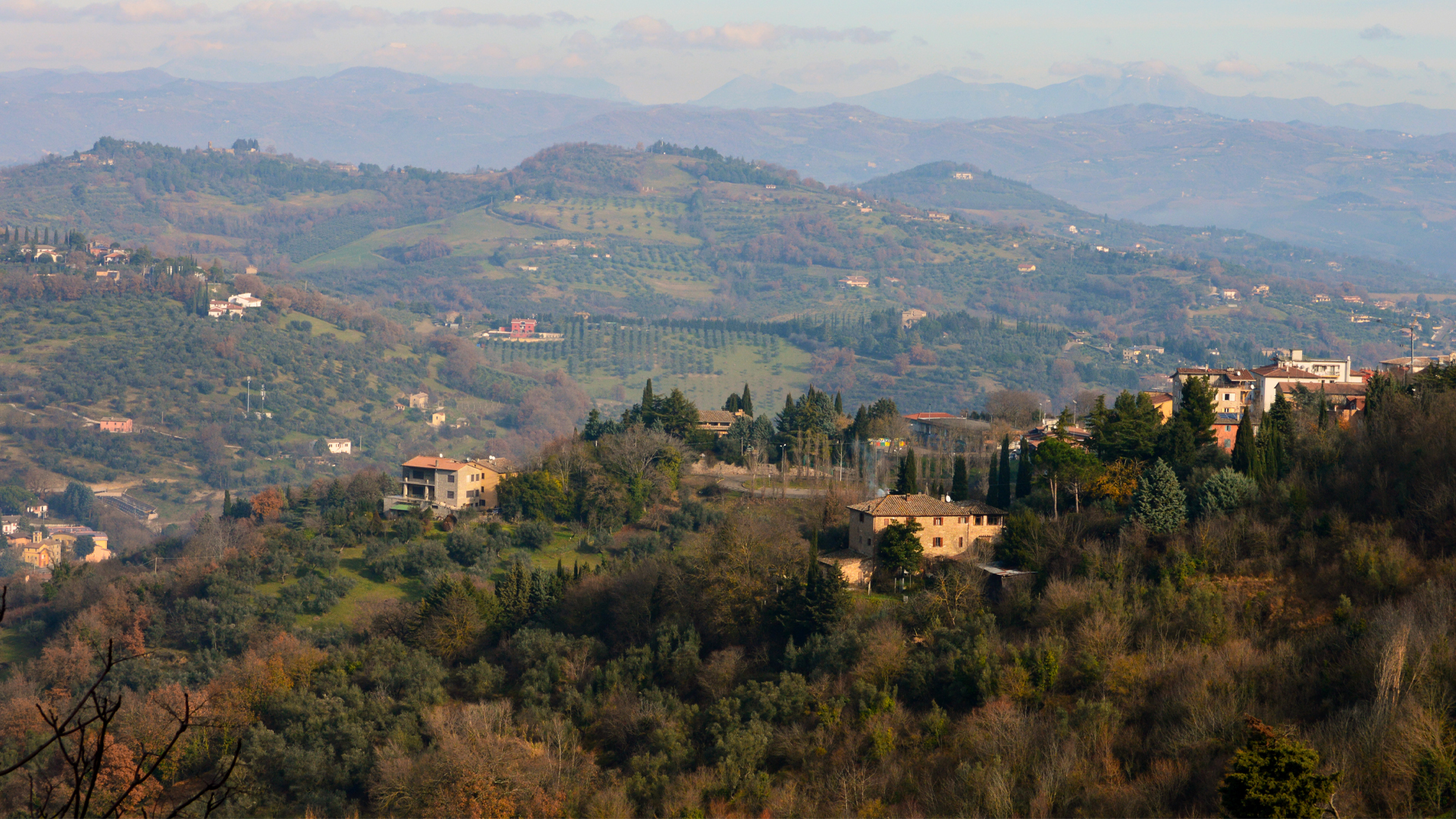Landlocked in the middle of Italy, discover the rolling hills and perfect sunsets.
Umbria has a prime location in central Italy. With no coastline, it nestles in the space between two of the most popular regions, Lazio and Tuscany. But visitors shouldn't let these neighbors steal the limelight. Where else can you wake up to fog rolling over the hills or sleep after picture-perfect sunsets?
If you’re looking to experience beauty, history, and traditions, Umbria needs to be on your list. Often called Italy’s "green heart," it’s known for its medieval hilltop towns and cuisine, particularly foraged truffles.
Assisi

(Photo Credit: Gullien Perez via Flickr)
Referred to as the "city of peace," Assisi is the birthplace of Saint Francis, the saint of animals. It is a leading destination for pilgrims. If you visit in June, you can experience the annual Festa della Lavanda (Lavender Festival). Besides the fields, enjoy guided walks and horse rides, and learn more about lavender, all within the backdrop of beautiful Assisi.
Visit:
St. Francis’ Basilica and Saint Clare’s churches.
Fly:
It’s not surprising that Balloon Adventures was a Travelers’ Choice Award Winner in 2021. Take a balloon flight to admire the area dotted with medieval villages, vineyards, and olive groves. Afterward, at Cantina Dionigi winery, you will enjoy a glass of Prosecco, breakfast, and Sagrantino wine tasting. ($204 per adult).
Spello
Located on the doorstep of Assisi, you can explore Spello on foot in a few hours. Spello avoids the crowds of Assisi but has just as much to offer. It may not have the cathedral that Asissi boasts, but what Spello lacks in architecture, it makes up for in charisma and great restaurants. Honey-colored homes cascade down the slopes of Saint Francis’s mountain (Monte Subasio). Well-preserved Roman arches form the entryways to the town. Due to Subasio marble, at sunrise and sunset, the town takes on a pink tone. Perfect for photos!
If you can, visit Infiorata (flower festival). In May and June, locals cover the streets with flowers, dubbing Spello the "Capital of Flowers."
Eat or sleep:
La Bastiglia restaurant, hotel, and spa have wonderful views from an extensive outdoor terrace.
Sleep:
Located in the heart of the countryside of Spello stands the B&B Il Castellaccio.
Pray:
Spello is full of churches. Visit the Church of San Andrea, San Lorenzo, San Claudio, Santa Maria di Vallegloria, and Saint Jerome with its adjoining monastery. Don’t miss the 11th-century Church of Santa Maria Maggiore, with its famous Baglioni Chapel and striking frescoes.
Pretty Perugia

(Photo Credit: Pom via Flickr)
Perugia is the regional capital and the site of the medieval Palazzo dei Priori. It is a vibrant, university hilltop town that revolves around its main pedestrianized street—Corso Vannucci. Each October, the city hosts a chocolate festival with tastings and statues made of chocolate. With such a focus on chocolate, what’s not to love?
See:
Galleria Nazionale dell’ Umbria, home to the greatest Umbrian art collection.
Eat:
Perugia’s truffles at Osteria a Priori, an all-Umbrian restaurant on Via dei Priori.
Try:
Olive oil at Trampolini, located a 15-minute walk outside Perugia’s historic center. Book a tasting tour and see their olive oil museum.
Listen:
For jazz lovers, the Umbria Jazz Festival takes place each July around Perugia. It is one of the world's most celebrated jazz events. International legends including Miles Davis, Dizzy Gillespie, and Wynton Marsalis have been a part of it.
Orvieto
Many discover Orvieto thanks to a train stop connecting Florence and Rome, while others are on their pilgrimage to Assisi. This captivating town is situated on a hilltop overlooking the mountainous scenery that Umbria is famous for. The real fascination is the mysterious grottos and underground tunnels created during the Etruscan period. They were used as shelters during World War Two.
See:

(Photo Credit: Carlo Raso via Flickr)
The Gothic Orvieto Cathedral for its breathtaking Renaissance artwork by Luca Signorelli.
Listen:
To Jazz. Orvieto is the site of Umbria Jazz Winter, a world-class experience for music lovers.
Todi
This hilltop town, overlooking the picturesque Tevere Valley, is surrounded by three sets of walls, built in different eras: Etruscan, Roman, and the Middle Ages. Explore the historic center from the Piazza del Popolo.
Photograph:
The stairs of the 12th-century Cathedral, located on the ruins of a temple dedicated to the god Apollo.
Visit:
The Town Hall, People’s Palace, and the Museum of Roman Etruscan. Don’t miss the 13th-century Captain Palace and St. Fortunato Church, honoring the city’s patron saint.
Admire:
The 16th-century Consolazione Temple with its impressive dome.
Stroll:
The maze of narrow streets in search of handicrafts.
Eat:
Pan caciato (a loaf containing walnuts, cheese, and raisins) and palomba alla ghiotta (roasted pigeon). Pair with a glass of Greschetto di Todi DOC.
Tasty truffles
A delicacy since ancient times, it was once considered a divine creation with aphrodisiac properties. Grown abundantly in the Umbrian countryside, you’ll find them everywhere - shaved on meats, used to flavor cheeses, and sautéed with butter for pasta sauce.
Prosciutto
This cured ham is internationally famous, but Prosciutto di Norcia is an Umbrian staple from Norcia. The term “Norcineria” is synonymous with quality meat not only in Umbria but Italy-wide.
Wine time
Umbria produces over seven million cases of wine annually, according to Italian Wine Central. The most famous winery in Umbria is the Lungarotti Winery, near the Tuscan border. They were responsible for the first DOC (Denominazione di Origine Controllata) of the region, as it ramped up production and quality in the 1960s.
Visit:
The winery and olive oil museum.Amanda Akien
Amanda Akien graduated from The University of Wollongong, Australia with an MA in Journalism with Distinction. Her writing has appeared in international travel magazines, as well as The Guardian newspaper. Although Amanda is based in the UK, she has traveled throughout Italy, even interning at a major modeling agency during Milan Fashion Week. Her favorite region is Tuscany - she loves Florence and is also partial to a glass of Montepulciano d’Abruzzo!


